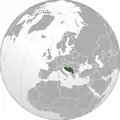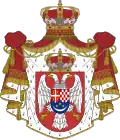Nigeria |
Yugoslavia |
|---|---|
.svg.png.webp)

Nigeria–Yugoslavia relations were historical foreign relations between Nigeria and the former Socialist Federal Republic of Yugoslavia. Formal diplomatic relations between the two countries were established in 1960 after the independence of Nigeria earlier that year.[1] Both countries were members of the Non-Aligned Movement and they developed their relations in the framework of the Cold War Third World cooperation. Yugoslavia was one of the founding members of the movement while Belgrade believed that the reason why Nigeria did not participate in the 1st Summit of the Non-Aligned Movement as one of the founding members was the result of discouragement by the United States as the decision was announced during the prime minister's visit to Washington, D.C.[2] During the existence of socialist Yugoslavia, both countries were organized as multi-ethnic federal states.
Two countries worked on the development of cultural, scientific and economic cooperation. Yugoslav construction companies were prominently engaged for the construction of the Lagos International Trade Fair as well as the old Parliament House building in Lagos.[3][4]
The experience of the violent breakup of Yugoslavia and Yugoslav Wars increased levels of anxiety among multiple commentators in Nigeria over the communal conflicts in that country and pushed them to call not to let Nigeria to become another Yugoslavia.[5][6][7][8] Following the breakup of Yugoslavia and Yugoslav Wars judge Adolphus Godwin Karibi-Whyte from Nigeria served at the International Criminal Tribunal for the former Yugoslavia.[9]
See also
References
- ↑ Radina Vučetić; Pol Bets; Radovan Cukić; Ana Sladojević (2017). Tito u Africi: slike solidarnosti (PDF). Museum of Yugoslavia. ISBN 978-86-84811-45-7. Archived (PDF) from the original on 2022-01-08. Retrieved 2022-03-07.
- ↑ Rakove, Robert B. (2014). "Two roads to Belgrade: the United States, Great Britain, and the first nonaligned conference". Cold War History. 14 (3): 337–357. doi:10.1080/14682745.2013.871528. S2CID 153513441.
- ↑ Niebyl, Donald (29 March 2020). "10 Works of Yugoslav Modernist Architecture in Africa & the Middle East". The Spomenik Database. Archived from the original on 8 November 2020. Retrieved 31 March 2020.
- ↑ Georgievski, Jovana (28 May 2020). "Jugoslavija, Tito i nesvrstani: Kako je socijalistička arhitektura osvojila Afriku" [Yugoslavia, Tito and the Non-Aligned: How Socialist Architecture Conquered Africa] (in Serbian). BBC Serbian. Archived from the original on 22 February 2022. Retrieved 7 March 2022.
- ↑ Atuma, Uche (12 April 2016). "The fear of Yugoslavia experience in Nigeria". SyndiGate Media Inc. ProQuest 1780024442. Retrieved 7 March 2022.
- ↑ Nwosu, Philip (12 September 2016). "Don't let Nigeria become another Yugoslavia, Ajayi cautions Buhari". The Sun (Nigeria). ProQuest 1818458502. Retrieved 7 March 2022.
- ↑ n.a. (3 November 1999). "Nigeria Must Learn From Yugoslavia's Experience". Africa News Service. ProQuest 449210491. Retrieved 7 March 2022.
- ↑ n.a. (30 September 2013). "At 53, Nigeria On the Road to Yugoslavia [opinion]". AllAfrica.com. ProQuest 1438195652. Retrieved 7 March 2022.
- ↑ "Former Judges". International Criminal Tribunal for the former Yugoslavia. n.d. Archived from the original on 18 February 2022. Retrieved 7 March 2022.


.svg.png.webp)